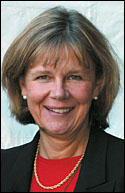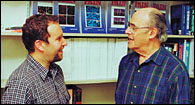Passing the Torch

About half of McGill's professors were hired during the 1960s and are poised to retire. But a bold plan and strong government support are luring some of the globe's top scholars to our doors.
A reputation is a fragile thing. You build it slowly over time, earning a new measure of respect with each fresh accomplishment.
McGill has few worries on the reputation front. According to Gallup polls done over the last decade, Canadians consistently view McGill as one of the finest universities in the land. In fact, McGill frequently places first overall. This autumn, the popular Kaplan/Newsweek How to Get Into College Guide listed McGill as one of the 12 "hottest" universities in North America.
|
|
 Dean of
Agricultural and Environmental Sciences Deborah Buszard Dean of
Agricultural and Environmental Sciences Deborah BuszardPHOTO: Andrew Dobrowolskyj |
|
|
|
What is worrisome is that many of the professors who have been instrumental in helping McGill build its remarkable reputation are heading towards the exits. "Academic renewal is the single most significant challenge that McGill faces over the next few years," declares Provost and Vice-Principal (Academic) Luc Vinet.
"McGill makes its most significant contributions to society based entirely on the quality of the brains we have at this university," suggests Dean of Agricultural and Environmental Sciences Deborah Buszard. She adds that McGill owes its glowing reputation, in large part, to the achievements of a generation of professors who won't be here much longer.
Handing over to a new generation
 Dr Ronald
Melzack (on the right) with his successor, Jeffrey Mogil. Dr Ronald
Melzack (on the right) with his successor, Jeffrey Mogil.PHOTO: Jack Goldsmith |
|
|
|
|
One of those leaving is Ronald Melzack. An emeritus professor of psychology, Melzack is largely responsible for changing the way everyone thinks about pain. Together with MIT's Patrick Wall, Melzack argued that pain wasn't a straightforward phenomenon -- that memories and emotions play an important role in determining how we experience pain. It was a radical notion at the time, but it is considered a truism today. He also designed the McGill Pain Questionnaire, used throughout the world to help physicians determine their patients' pain levels.
Melzack no longer pursues new research or supervises graduate students. He's writing a book and he still drops by his office to touch base with colleagues, but his career is winding down.
Enter Jeffrey Mogil, a young psychologist who has attracted widespread attention for his own studies of pain.
Mogil examines the genetic factors that help determine why different people experience pain in different ways. He is also looking at why drugs designed to help people cope with pain don't have the same effect on everyone who uses them. In particular, Mogil has detected that men and women don't seem to be wired in quite the same way when it comes to processing both pain and the medications that relieve it.
Two years ago, Melzack and Mogil were preparing to attend an international pain conference in Vienna. The widely respected Melzack was asked to introduce the up-and-comer Mogil at a presentation. The older psychologist asked his young colleague to send over some recent studies, so that Melzack could familarize himself with Mogil's work. Melzack liked what he read.
"A few weeks later, he called me up," recalls Mogil, who was working at the time at the University of Illinois at Urbana-Champaign. "He said, 'I'm about to retire and McGill is looking for someone to replace me as the EP Taylor Chair in Pain Studies. Promise me you'll apply.'
"I thought I was way too young for an endowed chair," recalls the thirty-something Mogil. "But Ronald Melzack is a living legend in my field and when somebody like that tells you to apply for a job, you apply for the job!"
McGill's future hinges on its ability to find dozens of Jeffrey Mogils capable of taking over for the Ronald Melzacks who are departing.
Road map for renewal
|
|
 Dean of Arts
Carman Miller. Dean of Arts
Carman Miller.PHOTO: Nicolas Morin |
|
|
|
Two years ago, Luc Vinet unveiled an ambitious plan: McGill would hire 1,000 new professors over a ten-year period, both to fill slots vacated by faculty members who are leaving and to increase the overall number of McGill professors by about 200. The University is trying to repair the damage caused by the departure of dozens of academics in the 1990s, professors who usually weren't replaced. To cope with that decade's deep cuts in government funding, McGill instituted a hiring freeze.
The faculty hit hardest by the freeze was the Faculty of Arts. Its student-to-professor ratio kept creeping up and overcrowded lecture halls became a common sight.
"The overall goal for McGill is to have about 20 students for each professor," says Dean of Arts Carman Miller, whose pleas for more staff eventually achieved results even he didn't expect. "He asked for 19 more positions," Vinet says with a grin. "We gave him 50."
"This represents a real breakthrough for our faculty," enthuses Miller. He suggests that the infusion of such new talents as political scientist Stephen Saideman, an ethnic conflict expert who advised the U.S. Joint Chiefs of Staff Strategic Planning Directorate on Bosnia, and Shakespearean scholar Paul Yachnin, the co-author of a recent book about what it was like to attend plays during the Bard's lifetime, is the key factor driving what he terms his faculty's "renaissance."
All told, Associate Vice-Principal (Academic Staff and Planning) Stuart Price estimates that by about 2010, two-thirds of McGill's faculty will have been hired during the preceding decade.
"At the end of this 10-year period, this will be a much different looking university. Hopefully, we'll look even better than we do right now."
In concert with McGill's deans and departmental chairs, Vinet has carefully plotted a road map for this renewal. The University will use many of its newest professors to pump fresh blood into some of its best-known programs. For instance, English professor Peter Sabor has been lured from Université Laval to take over the directorship of the Fanny Burney Project.
When it came to 18th-century England, Burney had a front row seat. She was one of the first successful female novelists, a playwright, an attendant to Queen Charlotte during the period chronicled in the film The Madness of King George, and a confidant of Samuel Johnson. Burney wrote it all down, leaving behind 10,000 manuscript pages filled with her recollections and observations. The bulk of the documents were tracked down in the 1950s by McGill English professor Joyce Hemlow. One of Burney's descendants had them stored in a trunk under her bed.
"The wonderful thing about Burney as a diarist is that she brings a novelist's gift for descriptive detail to the things she writes about," says Sabor. He has co-edited two of her novels as well as a collection of her plays. He has also examined some of Jane Austen's earliest writings and edited a newly revised edition of one of the most famous naughty books of all time -- John Cleland's Fanny Hill.
"I've spent the last 10 years working on Burney projects and this is the best place in the world to do that."


